Haben Sie sich von Ihrer WordPress-Website ausgesperrt?
Manchmal sperren Hacker Sie von Ihrer eigenen Website aus, indem sie Ihr Administratorkonto aus der Datenbank löschen.
In diesem Artikel zeigen wir Ihnen, wie Sie der WordPress-Datenbank über MySQL einen Admin-Benutzer hinzufügen können, damit Sie Ihren Zugang zurückbekommen.
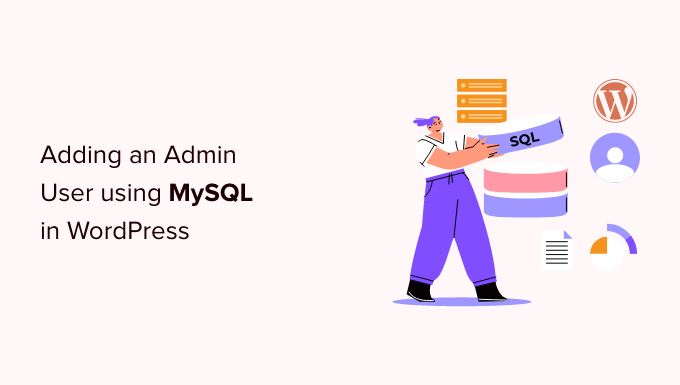
Warum einen Admin-Benutzer über MySQL zur WordPress-Datenbank hinzufügen?
Wir sind einmal auf ein Problem gestoßen, bei dem die Website eines Benutzers gehackt wurde und sein Administratorkonto aus der Datenbank gelöscht wurde. Dadurch wurde er von seiner WordPress-Website ausgesperrt.
Wir konnten ihnen helfen, Zugang zu ihrer Website zu erhalten, indem wir einen neuen Administrator-Benutzer direkt auf der WordPress-Website anlegten. Dazu verwendeten wir phpMyAdmin, ein webbasiertes Tool, mit dem Sie MySQL-Datenbanken über Ihren Webbrowser verwalten können.
Wenn Sie sich aufgrund von Hackern oder weil Sie Ihr Passwort vergessen haben, aus Ihrem WordPress-Administrationsbereich ausgesperrt haben, können Sie dies ebenfalls tun.
Sie sollten jedoch immer eine Sicherungskopie Ihrer Datenbank erstellen, bevor Sie irgendwelche MySQL-Bearbeitungen vornehmen. Sobald Sie sich wieder in Ihre Website einloggen können, sollten Sie unseren Leitfaden für Anfänger befolgen, um Ihre gehackte WordPress-Website zu reparieren.
Schauen wir uns also an, wie man einen Admin-Benutzer über MySQL zur WordPress-Datenbank hinzufügt.
Hinzufügen eines Admin-Benutzers zur WordPress-Datenbank mit phpMyAdmin
phpMyAdmin ist bei den meisten führenden WordPress-Hosting-Unternehmen vorinstalliert. Sie finden es im cPanel-Dashboard Ihres Hosting-Kontos im Bereich Datenbanken.
Hier ist ein Screenshot aus dem Bluehost-Kontrollzentrum:
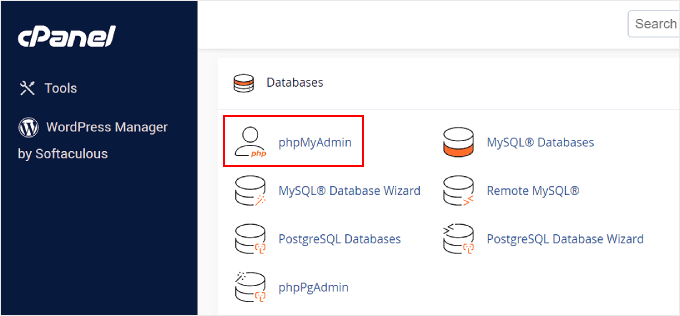
Wenn Sie auf das Symbol klicken, öffnet sich die phpMyAdmin-Oberfläche. Sie müssen Ihre WordPress-Datenbank in der linken Spalte auswählen.
Danach zeigt phpMyAdmin alle Tabellen in Ihrer WordPress-Datenbank an. Sie werden Änderungen an den Tabellen wp_users und wp_usermeta vornehmen.
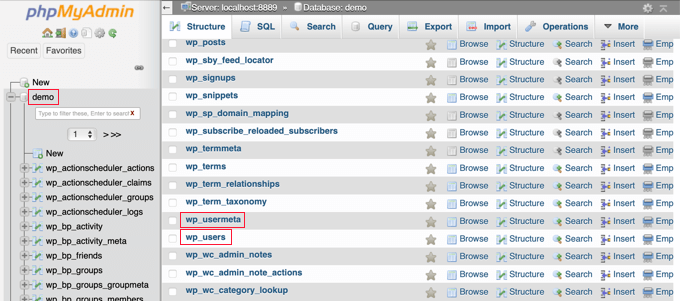
Hinzufügen eines Benutzers zur Tabelle wp_users
Zunächst müssen Sie die Tabelle wp_users finden und anklicken. Daraufhin werden die derzeit in der Tabelle aufgeführten Benutzer angezeigt.
Im Screenshot unten sehen Sie, dass es zwei Benutzer-IDs in der Tabelle unserer Demo-Website gibt, 1 und 2. Wenn wir einen neuen Benutzer für unsere Demo-Website anlegen, muss diese ID eindeutig sein, also geben wir die Nummer 3 ein.
Klicken Sie auf die Registerkarte „Einfügen“ am oberen Rand des Bildschirms, damit Sie die Informationen für einen neuen Verwaltungsbenutzer eingeben können.
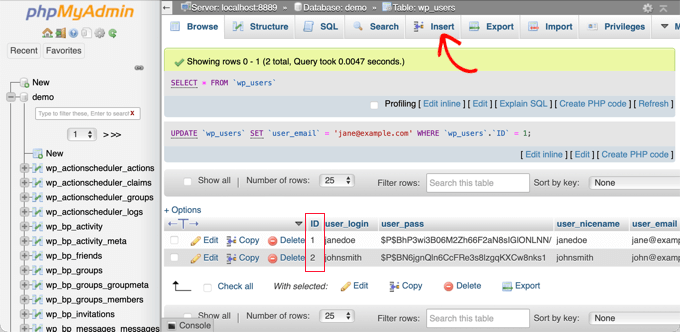
Fügen Sie die folgenden Informationen in die Felder des Formulars „Einfügen“ ein:
ID: Wählen Sie eine eindeutige Nummer (in unserem Beispiel verwenden wir 3)user_login: der Benutzername, der beim Einloggen verwendet wirduser_pass: Fügen Sie ein Passwort hinzu und stellen Sie sicher, dass Sie MD5 im Funktionsmenü auswählen (siehe Screenshot unten)user_nicename: der vollständige Name oder Spitzname des Benutzersuser_email: die E-Mail-Adresse des Benutzersuser_url: Ihre Website-Adresseuser_registered: Wählen Sie das Datum und die Uhrzeit der Registrierung des Benutzers über den Kalender aus.user_activation_key: leer lassenuser_status: setzen Sie diesen Wert auf 0display_name: der vollständige Name des Benutzers oder sein Anzeigename
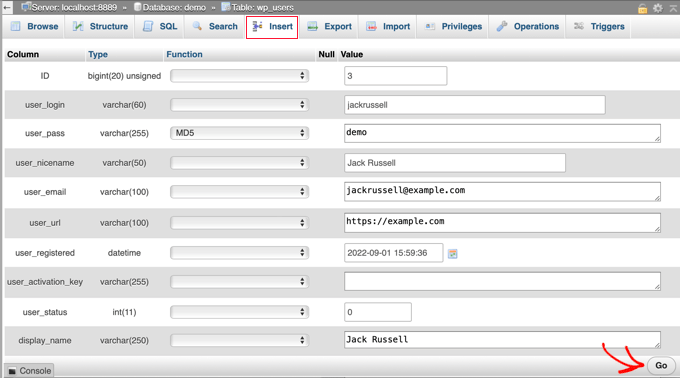
Wenn Sie fertig sind, klicken Sie auf die Schaltfläche „Go“, um den neuen Benutzer zu speichern.
Hinzufügen eines Benutzers zur wp_usermeta-Tabelle
Jetzt müssen Sie die Tabelle wp_usermeta finden und anklicken. Danach sollten Sie auf die Registerkarte „Einfügen“ klicken, wie Sie es im vorherigen Schritt getan haben.
Als Nächstes müssen Sie die folgenden Informationen in das Formular „Einfügen“ eingeben:
unmeta_id: leer lassen (sie wird automatisch generiert)user_id: die Benutzer-ID, die Sie im vorherigen Schritt verwendet habenmeta_key: dies solltewp_capabilitiesseinmeta_value: insert this:a:1:{s:13: "administrator";s:1: "1";}
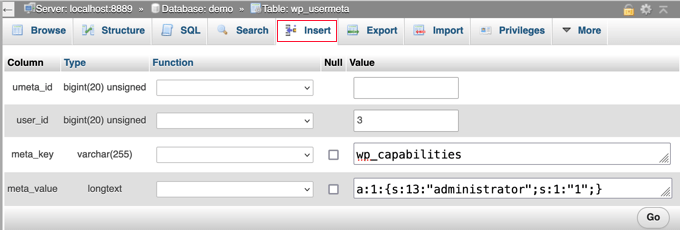
Wenn Sie dann nach unten scrollen, sollten Sie Felder für eine zweite Zeile finden. Sie müssen die folgenden Informationen hinzufügen:
unmeta_id: leer lassen (sie wird automatisch generiert)user_id: die Benutzer-ID, die Sie in den vorherigen Schritten verwendet habenmeta_key: Sie müssenwp_user_leveleingebenmeta_wert: 10

Wenn Sie alle Informationen in die Felder eingegeben haben, müssen Sie auf die Schaltfläche „Go“ klicken. Herzlichen Glückwunsch, Sie haben einen neuen Administrator-Benutzernamen erstellt!
Jetzt sollten Sie in der Lage sein, sich mit dem Benutzernamen und dem Passwort, die Sie für diesen Benutzer angegeben haben, in Ihrem WordPress-Administrationsbereich anzumelden.
Sobald Sie sich angemeldet haben, müssen Sie zu Benutzer “ Alle Benutzer navigieren und dann auf den gerade erstellten Benutzernamen klicken.
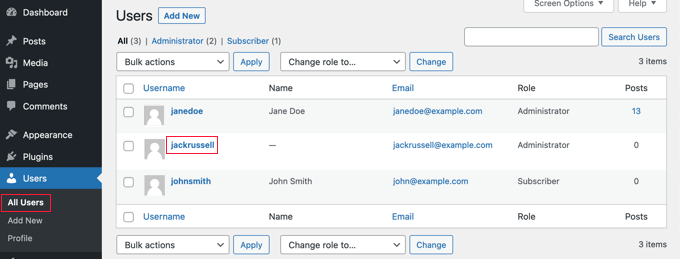
Blättern Sie nun, ohne etwas zu ändern, zum Ende der Seite und klicken Sie auf die Schaltfläche „Speichern“.
Dadurch kann WordPress den soeben erstellten Benutzer bereinigen und einige zusätzliche Informationen hinzufügen, die erforderlich sind.
Hinzufügen eines Admin-Benutzers zur WordPress-Datenbank mithilfe einer SQL-Abfrage
Wenn Sie ein Entwickler sind, können Sie den Prozess mit Code beschleunigen.
Legen Sie diese SQL-Abfrage einfach in Ihrer Datenbank ab:
INSERT INTO `databasename`.`wp_users` (`ID`, `user_login`, `user_pass`, `user_nicename`, `user_email`, `user_url`, `user_registered`, `user_activation_key`, `user_status`, `display_name`) VALUES ('3', 'demo', MD5('demo'), 'Your Name', 'test@example.com', 'http://www.example.com/', '2022-09-01 00:00:00', '', '0', 'Your Name');
INSERT INTO `databasename`.`wp_usermeta` (`umeta_id`, `user_id`, `meta_key`, `meta_value`) VALUES (NULL, '3', 'wp_capabilities', 'a:1:{s:13:"administrator";s:1:"1";}');
INSERT INTO `databasename`.`wp_usermeta` (`umeta_id`, `user_id`, `meta_key`, `meta_value`) VALUES (NULL, '3', 'wp_user_level', '10');
Stellen Sie sicher, dass Sie „databasename“ in die Datenbank ändern, mit der Sie arbeiten.
Vergessen Sie auch nicht, die anderen Werte so zu ändern, wie Sie es für den neuen Benutzer wünschen, wie wir es in der ersten Methode erklärt haben.
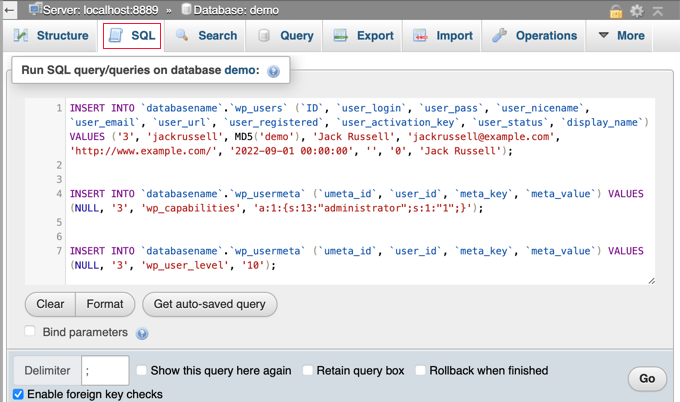
Expertenratschläge, was zu tun ist, wenn man aus dem WordPress-Admin ausgesperrt ist
Da Sie nun wissen, wie Sie einen Admin-Benutzer über MySQL hinzufügen können, möchten Sie vielleicht einige Artikel darüber lesen, wie Sie Ihre Website reparieren können, wenn Sie aus dem WordPress-Administrationsbereich ausgesperrt sind.
- Was ist zu tun, wenn Sie aus dem WordPress-Administrationsbereich (wp-admin) ausgesperrt sind?
- Wie man den WordPress-Wiederherstellungsmodus verwendet
- Wie man ein WordPress-Passwort von phpMyAdmin aus zurücksetzt
- Wie man die Beschränkung der Login-Versuche in WordPress aufhebt
- Deaktivieren aller Plugins, wenn kein Zugriff auf WP-Admin möglich ist
- Wie man den WordPress White Screen of Death behebt (Schritt für Schritt)
- Wie man den kritischen Fehler in WordPress behebt (Schritt für Schritt)
- Wie behebt man das Problem der Aktualisierung und Weiterleitung der WordPress-Login-Seite?
- So beheben Sie den Fehler beim Herstellen einer Datenbankverbindung in WordPress
- Wie man den Fehler „Diese Website kann nicht erreicht werden“ in WordPress leicht behebt
Wir hoffen, dass dieses Tutorial Ihnen geholfen hat, zu lernen, wie man einen Admin-Benutzer zur WordPress-Datenbank über MySQL hinzufügt. Vielleicht interessieren Sie sich auch für unseren ultimativen WordPress-Sicherheitsleitfaden oder unsere Liste der häufigsten WordPress-Fehler und deren Behebung.
Wenn Ihnen dieser Artikel gefallen hat, dann abonnieren Sie bitte unseren YouTube-Kanal für WordPress-Videotutorials. Sie können uns auch auf Twitter und Facebook finden.





Syed Balkhi says
Hey WPBeginner readers,
Did you know you can win exciting prizes by commenting on WPBeginner?
Every month, our top blog commenters will win HUGE rewards, including premium WordPress plugin licenses and cash prizes.
You can get more details about the contest from here.
Start sharing your thoughts below to stand a chance to win!
An says
This guide just made my life so much easier!
I don’t know you but I love you!
Thanks!
Max Johnson says
The user is inserted. The site accepts the credentials
but
site does not allow use of admin panel: /wp-admin
„Sorry, you are not allowed to access this page.“
This is WordPress 6.4.2 & PHP 8.2
WPBeginner Support says
That looks like a message from a security plugin or security setting from your hosting provider. You can try disabling any plugins following our guide below but if that does not work you would want to reach out to your host and they should be able to assist!
https://www.wpbeginner.com/plugins/how-to-deactivate-all-plugins-when-not-able-to-access-wp-admin/
Admin
Navin Rangar says
It’s not working for me, sadly. I’ve checked and everything is showing in the database tables, but the website says the email address is not registered. If I try username it says it’s not recognised. Any ideas would be gratefully received!
WPBeginner Support says
You may want to check that you do not have multiple databases in the chance that a placeholder site was set up when you first signed up with your hosting provider.
Admin
Kashif Ali says
I want Create Editor user in database ?
WPBeginner Support says
For editor users, we would recommend manually creating them through the WordPress interface using an admin account.
Admin
perceval hasselman says
I am so happy for your explanation. This saves me a lot of work.
It was hard to do without knowledge but this tutorial did it for me
Thanks a lot!
WPBeginner Support says
Happy to hear our guide was helpful!
Admin
Eleanor says
It’s not working for me, sadly. I’ve checked and everything is showing in the database tables, but the website says the email address is not registered. If I try username it says it’s not recognised. Any ideas would be gratefully received!
WPBeginner Support says
It is hard to say the specific reason but for an alternate method we would recommend trying the method from our guide below!
https://www.wpbeginner.com/wp-tutorials/how-to-add-an-admin-user-in-wordpress-using-ftp/
Admin
Lucas says
Thank you a lot. You save my life, bro. thks
WPBeginner Support says
Glad our guide was helpful!
Admin
newbie says
Hi there,
I’m trying to move my live wordpress site to my local server because I need to do an updates.
However after setting up in the local server I’m not able to login and I came accross this article
‚Adding an Admin User to the WordPress Database Using a SQL Query‘. My questions is the adding of this user should be done in the live server or my local server.
Thank you.
WPBeginner Support says
Instead of creating a new user on your localhost installation, we would first recommend going through our guide below:
https://www.wpbeginner.com/wp-tutorials/how-to-reset-wordpress-admin-password-on-localhost/
Admin
Sam says
Excellent article. Forgot login details after years of hiatus.
WPBeginner Support says
Glad our article was able to help!
Admin
daniele says
done but is not working for me. I created an account but wo see it as subscriber account not an admin.
WPBeginner Support says
There is a chance there was a typo in the query depending on the method you’re using. For a workaround you may want to take a look at the alternative method in our article below:
https://www.wpbeginner.com/wp-tutorials/how-to-add-an-admin-user-in-wordpress-using-ftp/
Admin
Nibedita says
Thanks for the tips it really worked and i could know a lot more about configuration i wordpress.
WPBeginner Support says
Glad our article could help you learn
Admin
Farkas Tibor says
Thanks, it saved me from a lot of work.
WPBeginner Support says
Glad our guide was helpful!
Admin
MKallas says
Thank you. This might come handy in other cases too… I made a Local AMPPS WordPress Install and for some reason first registrant got Subscriber rights instead of Admin. Really interesting. Anyways, PhpMyAdmin and fix of wp_usermeta -> wp_usercapabilities -> „a:1:{s:13:“administrator“;s:1:“1″;}“ sorted it out.
Andy says
Hi, thanks for the info. I’ve only been able to login as a general ‚User‘ using this method – I can’t see/access the Admin Dashboard. The site is a directory site that i migrated from a backup to a new domain. Any suggestions to get full admin privileges?
B A says
I come here 2-3 times a year to get that nice set of SQL boilerplate. Should probably just save it to my notes at this point. Thanks so much!
WPBeginner Support says
Glad our guide is able to continue to be helpful
Admin
Jana says
Thank you so much for this post! I had so many problems after migrating and changing the base url of my site and this post solved them all.
WPBeginner Support says
Glad our guide was able to help
Admin
Kristen says
I followed these steps and see my new account, but my site still will not allow me to log in. It says invalid user, then if I try resetting the password it says no account exists. What’s my next step to fix this?
WPBeginner Support says
You may want to ensure you added the user to the correct database, you should also be able to reach out to your hosting provider for them to take a look.
Admin
Kyle Eggleston says
Excellent, useful tutorial. Thanks for publishing.
WPBeginner Support says
You’re welcome
Admin
Stefan Pl says
1. Please change the post to include information about table prefixes – a problem that appeared quite a few times in the comments and will keep you from succeeding if you just follow the post and have an alternative prefix.
2. Thanks for the information presented here
WPBeginner Support says
Thank you for your feedback about our post
Admin
Mandy says
For everyone who can login but not see the wp-admin, these instructions aren’t wholly correct.
The wp_cabailities meta_value actually needs to be set as a:1:{s:13:“administrator“;b:1;}
Otherwise your user doesn’t end up with a role set and you can’t see wp-admin.
WPBeginner Support says
Thank you for sharing the code that worked for you
Admin
Jan says
Yes this also worked me, Many Thanks!
Cristina says
Hi. My WordPress website is being managed by a remote developer. He is an admin and so am I. We have a monthly agreement and I have every intention of paying him his dues. What measures can I do to make sure that I keep the access as well as my website should things go sideways? Can you please help me? Thanks in advance.
WPBeginner Support says
Create backups of your site and as long as you are the one paying for hosting you can restore the site
Admin
Janne says
Hi,
Thanks for writing this! I see I am not the only one who was looking for instructions. My user was created, and I can click on the „Reset password“ link and also get an e-mail from the system, but I am not able to log in. I saw that my „usermeta“ table looks different from the other users‘ – mine starts with „closedpostboxes_attachment“, not „first_name“ etc. What might be the reason for that?
j
WPBeginner Support says
That table is for meta boxes that you have closed, the order you’re seeing the table shouldn’t cause an issue
Admin
Sofia says
Hi!
I did all the process but when I log in to the dashboard I only see the „Welcome to WordPress“ section, I don’t see anything else in the admin area.
Please, can you help me?
WPBeginner Support says
Your hosting provider may have customized their login area, there is normally an advanced section you can go to or reach out to your host and they should be able to assist
Admin
Alexander Mtembenuzeni says
This was really helpful. Thank you!
WPBeginner Support says
Glad our post was helpful
Admin
Anisha says
Working on this for days. Thank you…
WPBeginner Support says
Glad our article could help you
Admin
Glenn Gordon says
I have a WP blog site which I have been locked out of. I created a new admin and can log in, but not to my dashboard. Instead, I go to my main blog page with my name and admin # at the top right and a logout button. How do I gain access to my admin/dashboard area?
WPBeginner Support says
You should be able to add /wp-admin to the end of your domain to get to your admin area but if you have a plugin locking you out, you could disable it using: https://www.wpbeginner.com/plugins/how-to-deactivate-all-plugins-when-not-able-to-access-wp-admin/
Admin
Asif says
Thank you very much!
WPBeginner Support says
You’re welcome
Admin
João says
Hello,
Well, this is embarrassing but… would anyone be able and kind enough to help me solve the father of problems? – wp_users table gone/missing…
Thank you in advance.
WPBeginner Support says
You would want to reach out to your hosting provider if that table is not with your database to see if they have a backup of your database to restore.
Admin
lhoucine says
hi! thank you for your tutorials,
i did all these steps and my issue still the same, when I want to login to my wp-admin, show me this message „Sorry, you are not allowed to access this page.“ please if know how to fix this I will so thankful
thank you
WPBeginner Support says
If the user was created, have you tried disabling your plugins in case you have a plugin that could be preventing access? https://www.wpbeginner.com/plugins/how-to-deactivate-all-plugins-when-not-able-to-access-wp-admin/
Admin
Theo says
Make sure you replace wp_capabilities with the correct prefix, if you are using a custom one, for example asdf_capabilities
Emmanuel Ekanem says
Thank you for this info, Theo.
wp_capabilities didn’t work for me cos mine is custom and it’s wpix_capabilities.
Thank you once again.
Holly Fitzgerald says
After backing up my database with updraftPlus, then restoring it, we lost all admin access. I followed these instructions but am still getting an error saying I do not have access. Help!
WPBeginner Support says
You would first want to reach out to updraftplus for your old login, some caching plugins can cause issues with what database your site is attempting to use. If that does not work you can force reset the password for your user using the method in our article here: https://www.wpbeginner.com/beginners-guide/how-to-reset-a-wordpress-password-from-phpmyadmin/
Admin
john juncal says
you are an absolute legend! after3 hours of trying useless suggestion from forums, you came up trumps, thank you!
WPBeginner Support says
Glad our article could help
Admin
stephane says
You Save my Life. Thank you so much!
WPBeginner Support says
Glad our article could be helpful
Admin
Gina says
EXCELLENT tutorial. Thank you so much!
mahmud says
many many thanks bro. you are genius.
Punam says
Many Many thank.. it is very helpful to me and my site work perfectly…
Taieuro says
Thanks your information!
But after inserting a admin accout, i can not login my site.
Appear „Protection“ button stop me to login WP dashboard.
Please help me!
WPBeginner Support says
Hi Taieuro,
Please try steps in our WordPress troubleshooting guide, it will help you figure out what’s causing the issue.
Admin
Matthew says
Didn’t work, I’m getting the „Sorry, you are not allowed to access this page.“ message. I checked my wp-config.php and the prefix is „wp_“ but it still doesn’t work. Any ideas?
Cavid Muradov says
You helped my life, thank you very much.
Julia says
Thank you so much. Worked perfectly. You helped me so much!
Julia
Rivhie says
How did you do it? It didn’t work for me.
Chakerz says
Hi,
change „wp_“ to your installation prefix !!
UgoChukwu Agbams says
Thank you very much. This article really helped me a lot, after my admin account was set to customer by a plugin I set to change user role from whatever to customer when they made a purchase.
I never knew it will affect the admin role as well.
JOEL says
Very good, great info. The SQL worked super fast so thumbs up!
kerry says
is there a common reason why user can login but Dashboard is not made available? I see a lot of meta key values in the db
Jules says
Thank you, this has been very helpful.
PM says
Thank you sooooo much for this. Just this morning my wordpress site was hacked and I could not login into wp-admin. It was giving „user not found“ error. I used this to fix things in my hostgator account.
Very very grateful. Written instructions are excellent but the video could be slower with more details.
joel says
Hi all,
it didn’t work for me…
an error message tell me that I can’t access to the dashboard
!!HELP !!
Anup Poudel says
It is simple mate.See what is written in you database name.
Like in my case it was wprn_capabilities,wprn_user_level..
James Denning says
I have the same problem. No matter what I do the user does not have any privliges
Shaheen says
I messed around with this more; watched the video several times and it’s still not working.
In my case, I lost admin access after I migrated my WP site from one hosting account to another.
my old admin login is able to login but once in, isn’t able to do anything.
Using mysql, i tried creating a new user and adding the meta data. When I try to login with the new user, it says the password is incorrect. I tried saying „forgot password“ and I did not receive any email to the email address i included when making the user with msql.
In mysql i can see my old admin user is still there. I tried adding meta data to give admin privledges to that user, by putting in the corresponding userID. This didn’t change anything. I am still able to login with that user but don’t have access to anything. If anyone has any advice it would be much appreciated!
zohaib says
Thanks a lot, Yes I got my problem solved and this was due to the the role assigned to my user name. Cheers
Bichir Mihail says
Thanks, really helpfull